After landing at Windhoek’s International Hosea Kutako Airport, about 40km outside of Windhoek, you will be welcomed by Mary-Anne and our safari guide from Ultimate Safaris who will transfer you to the Galton House where we stay overnight.
We take the rest of the afternoon to relax and recover from our flights.
Later on, Mary-Anne will gather us all together to go over our artistic aims for the trip, talking about how we like to work and thinking about our expectations for the tour. Our safari guide will also talk through the itinerary with you.
In the evenings (during the whole tour) we tend to gather (often in fairly dim light) to discuss and admire our creative efforts, successes and ideas of the day. You may find this daunting at first, as you will be showing often unfinished and incomplete works, but it soon becomes a fun, binding and explorative time of day where you can learn from everyone in the group.
Throughout your time we hope you will continue to ask questions and learn from Mary-Anne, improving your sketching and painting techniques and observational skills and playing with all the art materials you have brought with you.
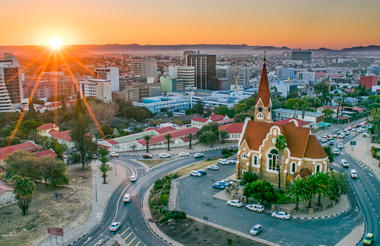
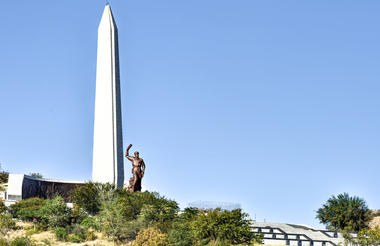
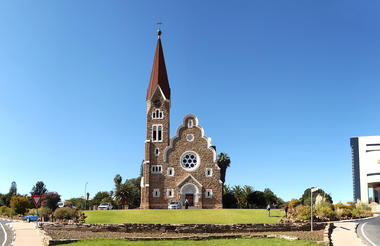
This morning, after breakfast, we set off from Galton House with our guide in our safari vehicle and drive southwest through the scenic Khomas Hochland highlands before heading down the Great Escarpment into the Namib Desert below, stopping for a picnic lunch at a scenic location along the way.
We arrive at Camp Sossus in the mid-afternoon where we will stay for two nights.
This afternoon we have the option to sketch in the surrounding area with our guide, perhaps by foot, ending with sundowners overlooking the vast desert plains.
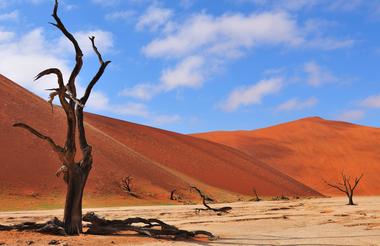

This morning there’s a magical excursion into the Namib Naukluft National Park, entering the park gates at sunrise to capture the dunes whilst the light is soft, and shadows accentuate their towering shapes and curves. This area boasts some of the highest free-standing sand dunes in the world.
We aim to spend most of the day in the iconic dune area, including Dead Vlei and the Sossusvlei pan, which sometimes has water at this time of year. We will be taking brunch with us and painting these mountainous dunes in all their colours throughout the morning.
The contrast of the giant red dunes against clear blue skies, their towering shapes and graceful curves, the ever-changing light and shadows, and the shimmering colours of the sand make this one of the most scenic natural wonders of Africa.
This area is a great one for thinking of brushes – taking only a very large brush to lay the skies and the sands, before taking a small brush for the tiniest of details to create scale.
Namibia is very unique, let its individual wilderness appear in your photos and sketches. Every day make sure you also make some thumbnail sketches of the area you are in, (including the lodge), you will start to notice the subtle differences (and the big ones) in habitat and light. At times it is all too easy just to focus in on the animals and to forget to concentrate on a sense of place.
Energetic artists may be inspired to climb one of the dunes - a challenging task but the view from the top and the fun sliding down m akes it worth all worthwhile!
Our guide will give insights on the formation of the Namib Desert and its myriad of fascinating creatures and plants that have adapted to survive these harsh environs.
We then return to Camp Sossus in the early afternoon for a late lunch, stopping off to view Sesriem Canyon along the way. The rest of the afternoon is at leisure (from experience, this is usually welcomed after an exhilarating morning in the dunes) or painting!
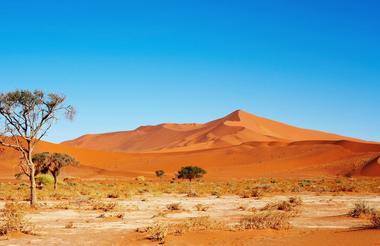
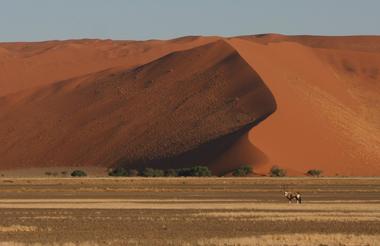
The itinerary as planned is a fascinating drive today takes us northwest through awesome and ever-changing desert landscapes of the Namib Naukluft National Park, including the impressive Gaub and Kuiseb canyons. Please talk to Mary-Anne or Hollie in advance about the possibility of flying*
We meet the coast at the port town of Walvis Bay and then continue north to Swakopmund where we can enjoy the pleasant seaside location and cooler coastal air. Depending on the time of arrival, we may have some time free to explore the town of Swakopmund by foot before heading to dinner at a popular restaurant in town.
*NOTE: As an alternative to the driving from Dead Valley Lodge to Swakopmund you may opt to take an eye-wateringly expensive scenic light aircraft flight over Sossusvlei and along the Diamond Coast (optional extra at additional cost), allowing you a bird’s eye view over the dune sea, abandoned mining camps, shipwrecks, Sandwich Harbour and salt pans before you land at Swakopmund Airport.
The guide will drive ahead with the luggage and meet up with us in Swakopmund later in the day.
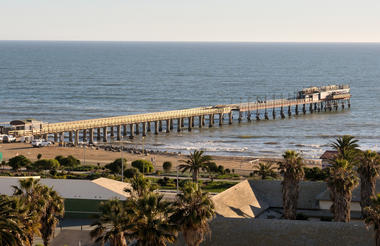
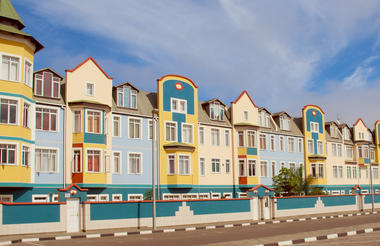
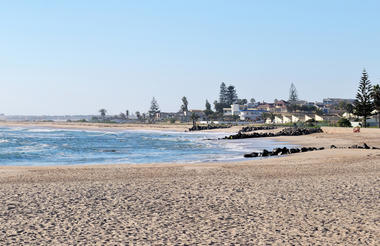
We have a full day to enjoy Swakopmund.
This morning we head to Walvis Bay Waterfront for a marine educational sightseeing tour in the bay area in search of the marine big 5: Whales, Dolphins, Mola, Leatherback turtle and seals. While being served hot coffee and tea, the route takes you past oyster farms as you approach Pelican Point with its landmark lighthouse and 60,000 resident cape fur seals. In season (July to November), larger mammals such as the Southern Right Whale and Humpback Whales are sometimes spotted, while other whale species, such as the Gray whale and the Pygmy Right whale have made rare appearances.
Bottlenose, Heaviside and Dusky dolphins can be occasionally seen, as are Mola Molas and Leatherback Turtles. Accompanying the catamarans throughout are a variety of seabirds, such as the Kelp Gull, Hartlaub’s Gull, Pelicans and Cape Cormorant. Your journey from Pelican Point takes you past some of the more interesting ships and oil rigs in the bay as you are served fresh oysters with sparkling wine, savoury snacks and desserts together with light drinks, cool drinks and water. Your return to the Waterfront will be around 12h15.
Alternative option – We also have the chance to do a Kayaking trip to try and spot the fur seals. This option would be suitable for beginners and would be an alternative to the catamaran tour of the bay. We will gauge interest from the group before changing the itinerary.
In the afternoon we might like to enjoy the café culture, explore the shops and curio market, or settle in to some sketching. The lighthouse and coastline make for great subjects.
Those who are feeling energetic might like to climb some of the surrounding white dunes or practise painting their forms in the changing light.
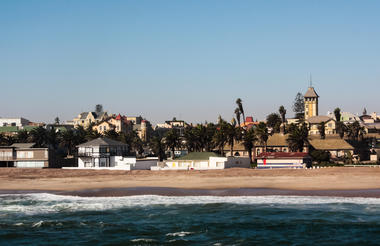
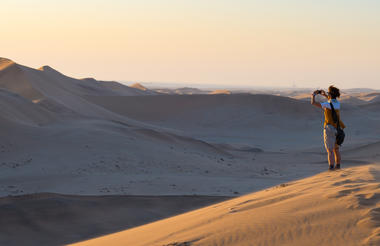
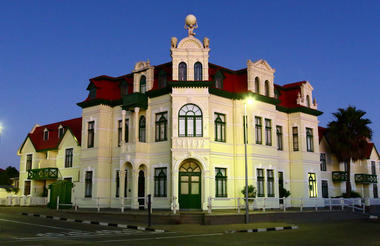
After a leisurely breakfast we depart Swakopmund heading north along the coastline, visiting the haunting remains of the Zeila Shipwreck just south of the town of Henties Bay. Although it’s a relatively modern wreck, it is full of atmosphere for us painters. We then continue to the Cape Cross Lodge where we will stay for the night as I feel it is essential (though smelly) to sketch at the remarkable seal colony at Cape Cross.
The Skeleton Coast earns its name from the many shipwrecks and the ghosts of their sailors that litter this eerie coast. The fog that rolls in from the Atlantic gives the entire coast a mystical feel and on our little headland we’re often in sunshine.
The rocky promontory at Cape Cross with its huge rollers is home to thousands of seals and their pups, and it’s wonderful to draw these animals in such proximity! They are certainly truly smelly, but totally enthralling, and we anticipate spending a good number of hours with them.
The Zeila: The Zeila was stranded on 25 August 2008 in the early morning hours near "Die Walle", a popular fishing spot about 14km south of Henties Bay. The fishing trawler was sold as scrap metal to an Indian company by Hangana Fishing of Walvis Bay and ran aground after it came loose from its towing line while on its way to Bombay, India shortly after it left Walvis Bay. The rusting bulk is now home to hundreds of perching cormorants and other seabirds, an ominous reminder of why this stretch of beach is referred to as the Skeleton Coast.



This morning we depart from Cape Cross Lodge and head northeast to Spitzkoppe, an area home to large rocky outcrops of bald granite peaks in hues of yellow and orange that rise majestically from the surrounding flat desert.
Spitzkoppen lodge is situated on the northern periphery of the Spitzkoppe Inselberg, between huge granite boulders created more than 150 million years ago, with breath-taking views onto the Brandberg and Erongo Mountains. The stylish accommodation consists of 15 spacious chalets, each with private bathroom and outside viewing deck. The Dining, Lounge, and Bar Area opens onto the pool deck, with a 360° view onto the Granite Boulders which are lit at night. From an elevated spot, guests can have a famous sun-downer platter and experience the unique bio-diverse environment.
Spitzkoppen Lodge offers a variety of quality recreational activities, with an emphasis on “responsible recreation in a fragile environment”. Activities include mountain hiking, nocturnal safaris, cycling tours, rock climbing, guided tours to archaeological sites, including Bushman’s Paradise National Monument, Small Bushman’s Paradise, Golden Snake Painting, and more.
The Grosse and Kleine Spitzkoppe mountains are important sites in describing patterns of hunter gatherer settlement and subsistence that occurred in the area, until the introduction of livestock during the previous millennium. Evidence is documented at over 40 rock-art sites. In addition to their historical significance the cultural and spiritual value of the sites makes the Spitzkoppe an important heritage area for all Namibians. Guests can also use the lodge's maps and experience the incredible stars from the nearby famous Rock Arch.
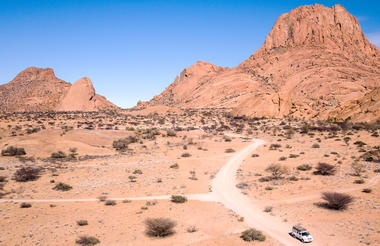
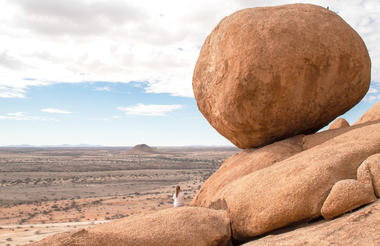
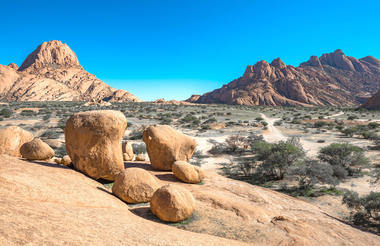
This morning we depart from Cape Cross Lodge and head northeast to Cheetah View Lodge, passing by small towns along the way while making our way towards Otjiwarongo. We enjoy a picnic lunch at a scenic location en-route. We can expect the journey to take around 4 ½ to 5 hours (not including stops).
Afternoon arrival at the lodge with some time to freshen up before setting off for an afternoon game drive on the lodge reserve.
This is a lodge that is well known by our Namibian hosts, but I have not yet been there. We should have the opportunity to spend time sketching the cheetahs as I have in other lodges before. They have been primed!
We return to the lodge after sunset before settling down for dinner.



The next two days will be spent embarking on various sketching sessions and game activities with the lodge including sketching in the cheetah run, as well as a tour of the CCF facilities. We also take a drive to see the ambassador cheetahs.
Learn more about the workings of this world-renowned project while getting time to sketch these incredible animals.



Cheetah Conservation Fund: CCF's focus is on research, conservation and education. An extensive modern Visitor and Education Centre encourages visitors to learn about cheetahs, their habitat, and issues of conservation, with an opportunity to see resident non-releasable cheetahs, acting as 'cheetah ambassadors' for the species.
A stop over at CCF makes a very worthwhile, enjoyable, and informative visit for the tourist. The large modern Education Centre houses a museum that provides visitors and students the opportunity to learn more about the behaviour and biology of the cheetah, and the Namibian ecosystem that supports Africa's most endangered cat species. The excellent graphics and interactive displays in the centre bring the visitor through the history of the cheetah from pre-history to modern times and explain how their range and numbers have diminished.
Other exhibits show where the cheetah fits into the cat species family tree, how the cheetah differs from the 36 other cat species, how the cheetah is adapted for a highspeed sprint and its specialized hunting techniques, and finally, the cheetah's lifecycle from cub to adult. A life-size 'play tree' shows the importance of these trees in a cheetah's territory.
Continuing through the Education Centre, the visitor can learn about other aspects of conservation and the work of CCF: for example, how the cheetah lives within an ecosystem together with prey, and how farmers can live with cheetahs on their land by using non-lethal predator control methods, a prime example being the use of Kangal Anatolian Livestock Guarding Dogs from Turkey. CCF has been promoting the use of these dogs since 1994, breeding and donating them to Namibian farmers to guard their flocks. Finally, a Future Room highlights the need for continued research so that humans and nature can live together. The Research Centre houses a veterinary clinic, laboratory and main offices. The Visitor's Centre has a large meeting room, gift shop, veranda and the predator prey ground' outside is a learning area for school groups and children of all ages. Enjoy the view of the Waterberg Plateau from the veranda and relax in the landscaped courtyard with native gardens and an attractive sculpture of a cheetah.



After an early breakfast, we drive to Etosha National Park to reach Mushara Bush Camp situated close to the Namutoni Gate into the Park.
We spend another morning on an exciting activity before returning for hearty brunch. After brunch and freshening up we depart and head for the Etosha National Park in the late morning. We should arrive at the eastern Etosha side in the mid-afternoon.
This afternoon our guide could take us on our first game drive into the Etosha National Park, returning to camp in time to freshen up for dinner. Alternatively, we might like to explore our surrounding area or simply relax at the camp; soaking in the peaceful scenery.
You can expect to fill your sketchbooks with the stripes of zebras and the dramatic horns of gemsbok, as well as many other antelope. Rhinos, lions, elephant, cheetah, giraffe and many other animals might also be our subjects over the next few days.
Some of the wildlife drawing techniques will come in handy here; you will learn all about ‘blink sketches’, external and internal shapes, scribbling, tone, backbones, weight distribution, feet and all sorts of other things; but more of this when we’re there!
On all our days we follow our guide’s advice about the most likely areas to find interesting subjects to sketch and on planning lunches to fit in with our itinerary for the day.
Mary-Anne will help the momentum of these sketches by giving you exercises and encouragement. She will draw alongside you as well; it is fascinating to watch her sketchbook pages fill.
As in all our trips on later days into the park, anyone who has come to look at the view rather than sketch will be royally rewarded by what they see. We anticipate that you will be full of questions about sketching and painting for Mary-Anne, and about the wildlife and the habitat of Etosha for our guides.
Over the next few days, we visit the Park for some exciting game viewing and sketching. We hope to gather images of as many animals as we can, including lion, leopard, giraffe, zebra and springbok, but also some of the birds of the bush.



The next 2 full days will be devoted to discovering all the winding roads and waterholes of the Etosha National Park, giving ample opportunity to explore and experience all that the park has to offer in terms of fauna and flora.
Lunch may either be enjoyed at camp, at one of the resorts in the park or, if we all agree, we could opt to spend the whole day in the park with a picnic lunch at a scenic location. Either way, we will exit the park before sunset, arriving back at the lodge with enough time to freshen up for dinner.
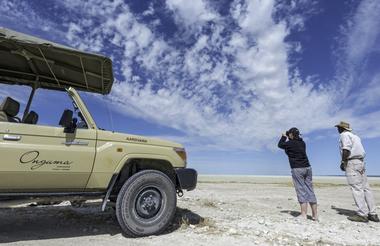


Game drives in Etosha.
Etosha National Park: Etosha National Park covers 22,270km², of which approximately 5,000km² is made up of saline depressions or pans. The largest of these pans, the Etosha Pan, can be classified as a saline desert in its own right. The Etosha Pan lies in the Owambo Basin, on the north-western edge of the Namibian Kalahari Desert. Until three million years ago it formed part of huge, shallow lake that was reduced to a complex of salt pans when the major river that fed it, the Kunene, changed course and began to flow to the Atlantic instead. If the lake existed today, it would be the third largest in the world. Etosha is the largest of the pans at 4,760km² in extent. It is nowadays filled with water only when enough rain falls to the north in Angola, inducing floods to flow southward along the Cuvelai drainage system.
The Park consists of grassland, woodland, and savannah. Game-viewing centres on the numerous springs and waterholes where several different species can often be seen at one time. The Park boasts some 114 mammal and over 340 bird species. Wildlife that one might see includes elephant, lion, giraffe, blue wildebeest, eland, kudu, gemsbok (Oryx), zebra, rhino, cheetah, leopard, hyena, honey badger and warthog, as well as the endemic black faced impala.


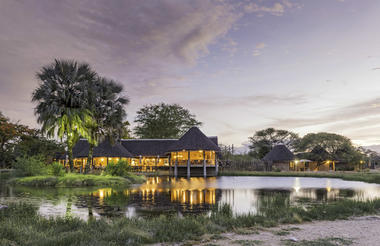
After an early breakfast we set off on our journey back to Windhoek. The road takes us south through Namibia’s central highlands and commercial farmlands to reach Windhoek. On arrival in Windhoek our guide will transfer us to the Galton House for the last night of the Art Safari.
We gather for drinks with our sketchbooks to look at the mass of images we have collected and to share the memories, along with our plans for future paintings once we get home.
This evening our guides will take us out to dinner at one of the popular restaurants in town to reminisce about trip highlights and good memories.
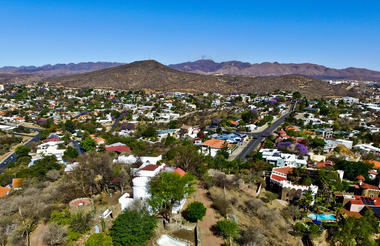
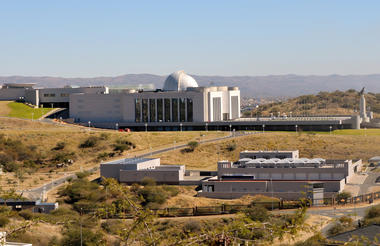
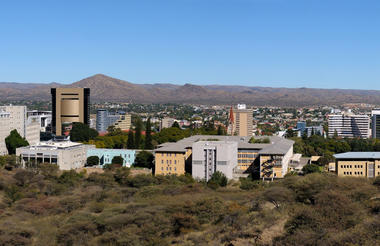
This morning can be spent relaxing at our guesthouse, exploring Windhoek, visiting NamCrafts and the Craft Centre, or doing some last-minute souvenir shopping if time allows, before our guide collects us from the guesthouse for our transfer out to the Windhoek International Airport, getting us there in time to check in for our ongoing flight.





